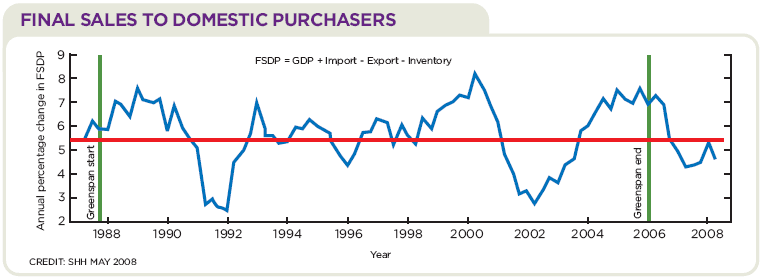
Military history is written by the victors. Economic history is written, to a large extent, by central bankers. In both cases you have to take official accounts with a large dose of salt.
Just consider the bubble-blowing charges leveled at the former chairman of the Federal Reserve, Alan Greenspan. The former chairman has proclaimed his innocence. Let’s look at the evidence.
What is a bubble? A bubble is created when the Fed’s laxity allows aggregate demand to grow too rapidly. Specifically, a demand bubble occurs when nominal final sales to US purchasers (GDP minus exports, plus imports, minus change in inventories) exceeds its trend rate of growth by a significant amount.
During Greenspan’s 18-year tenure as Fed chairman, nominal final sales grew at a 5.4% annual trend rate. This reflects a combination of real sales growth of 3% and inflation of 2.4%. (see chart)

Click on chart for larger view
The first deviation from the trend began shortly after Greenspan became chairman. In response to the October 1987 stock market crash, the Fed turned on its money pump and created a bubble: during the next year final sales shot up at a 7.5% rate, well above the trend line. Having gone too far, the Fed then lurched back in the other direction. The ensuing Fed tightening produced a mild recession in 1991.
From 1992 through 1997 growth in the nominal value of final sales was quite stable. But successive collapses in certain Asian currencies, the Russian ruble, the Long Term Capital Management hedge fund and finally the Brazilian real triggered another excessive Fed liquidity injection. This resulted in a boom in nominal final sales and a bubble in 1999-2000. This was followed by another round of Fed tightening, which coincided with the bursting of the equity bubble and a slump in 2001.
The last big jump in nominal final sales was set off by the Fed’s liquidity injection to fend off the false deflation scare in 2002. As Greenspan put it, “We face new challenges in maintaining price stability, specifically to prevent inflation from falling too low.” By July 2003, the Fed funds rate was at a record low of 1%, where it stayed for a year. This set off the mother of all liquidity cycles and yet another massive demand bubble.
During the Greenspan years, and contrary to his claims, the Fed overreacted to real or perceived crises and created three demand bubbles. The last represents one bubble too many – and one that is impacting us today.
Author Steve H. Hanke

0 responses on "Greenspan’s Bubbles"